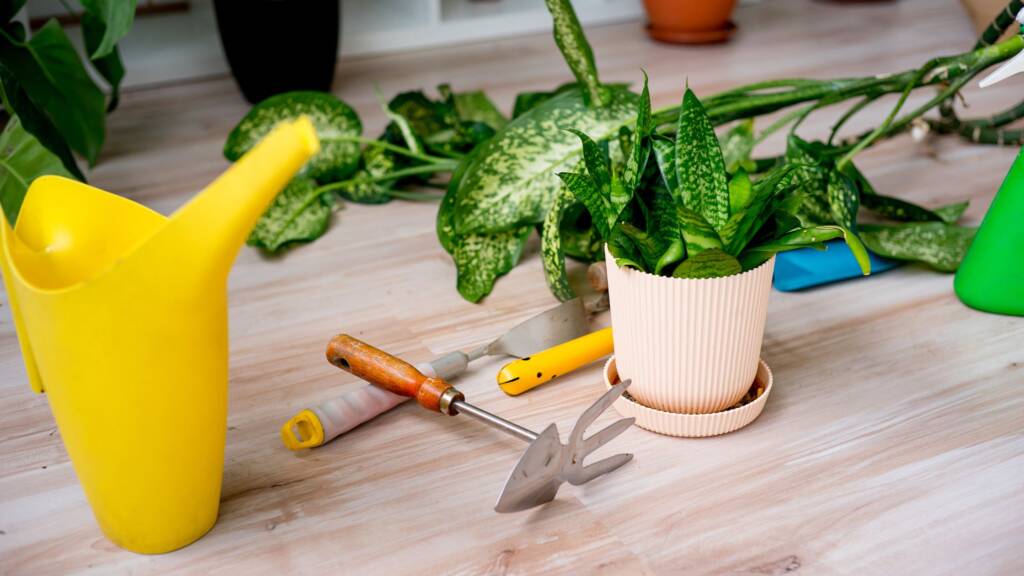
Having the right tools can make gardening tasks easier and more enjoyable. Here’s a list of essential garden tools and their uses:

1. Hand Trowel
Use:
- Digging small holes for planting seeds, bulbs, or seedlings.
- Transplanting plants and removing weeds.
- Scooping soil, compost, or fertilizer.
2. Pruning Shears (Secateurs)
Use:
- Cutting back dead or overgrown branches, stems, and flowers.
- Harvesting herbs, vegetables, and fruits.
- Shaping plants and shrubs.
3. Garden Fork
Use:
- Breaking up compacted soil.
- Turning and aerating soil.
- Mixing in compost or fertilizer.
4. Spade
Use:
- Digging, lifting, and moving soil.
- Edging garden beds.
- Planting shrubs and small trees.
5. Hoe
Use:
- Loosening soil for planting.
- Removing weeds and clearing garden beds.
- Shaping soil around plants.
6. Rake
- Types and Uses:
- Leaf Rake: Gathering leaves, grass clippings, and light debris.
- Garden Rake: Leveling soil and removing rocks or weeds from garden beds.
7. Watering Can
Use:
- Watering plants, especially in containers and hanging baskets.
- Comes with a spout for targeted watering or a rose attachment for a gentle shower.
8. Garden Hose with Spray Nozzle
Use:
- Watering large garden areas.
- Spray nozzles allow for adjustable water pressure, from a mist for delicate plants to a strong jet for cleaning.
9. Wheelbarrow
Use:
- Transporting soil, compost, mulch, plants, or heavy tools.
- Ideal for larger gardens to reduce physical strain.
10. Garden Gloves
Use:
- Protecting hands from dirt, thorns, blisters, and cuts.
- Enhancing grip for tasks like pruning and digging.
11. Loppers
Use:
- Cutting thicker branches and stems that pruning shears can’t handle.
- Trimming trees and shrubs.
12. Garden Knife (e.g., Hori Hori Knife)
Use:
- Cutting through roots, twine, or tough plant materials.
- Digging and weeding.
- Planting bulbs or dividing perennials.
13. Weeder
Use:
- Removing deep-rooted weeds from garden beds or lawns.
- Working in tight spaces without disturbing nearby plants.

14. Garden Scissors
Use:
- Snipping herbs, flowers, or soft stems.
- Deadheading flowers.
- General light pruning and shaping tasks.
15. Cultivator
Use:
- Loosening soil for better aeration and water penetration.
- Mixing fertilizer or compost into the soil.
- Removing shallow weeds.
16. Garden Hoe
Use:
- Loosening soil and removing weeds from rows in vegetable gardens.
- Creating shallow trenches for planting seeds.
17. Sprayer
Use:
- Applying pesticides, herbicides, or liquid fertilizers evenly.
- Cleaning tools and surfaces with water or disinfectant.
18. Garden Shovel
Use:
- Digging, scooping, and moving soil, mulch, or gravel.
- Planting trees or shrubs.
19. Hedge Shears
Use:
- Trimming hedges, bushes, and shrubs to maintain shape and size.
- Cutting through soft wood and small branches.
20. Garden Kneeler or Pad
Use:
- Protecting knees while working on the ground.
- Reducing strain during prolonged gardening tasks.
Tips for Tool Maintenance
- Clean Tools After Use: Remove dirt and debris to prevent rust and damage.
- Sharpen Blades: Keep cutting tools like pruners, shears, and knives sharp for efficient use.
- Oil Moving Parts: Lubricate tools like shears and loppers to keep them functioning smoothly.
- Store Properly: Keep tools in a dry, clean place to extend their lifespan.
By investing in these essential tools and maintaining them, you’ll create a well-equipped and efficient garden workspace! 🌱

